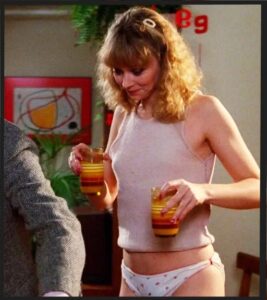Night Shift: Hidden Surprises Behind the 1980s Cult Comedy

What happens when you put together Henry Winkler’s quiet charm and Michael Keaton’s whirlwind of energy? You get Night Shift (1982) — a quirky comedy that became an unexpected cult favorite and launched careers in surprising ways.
Directed by Ron Howard in his first big outing behind the camera, Night Shift takes audiences from the somber halls of a morgue to pure comedic mayhem. With Shelley Long’s sweetness lighting up the screen and cameos from future stars like Kevin Costner and Shannen Doherty, this film became more than just a comedy — it was a sneak peek at Hollywood’s future.
But there’s much more hidden behind the laughs. From on-set tension to almost-cast legends, and even a musical debut that would later raise millions for charity, the secrets of Night Shift are worth revisiting.
From the Morgue to Mayhem
The story centers on Chuck Lumley (Henry Winkler), a timid night worker at a New York morgue, who’s thrown off balance when paired with Bill Blazejowski (Michael Keaton), a motor-mouthed, idea-spewing coworker. Together, they stumble into the world’s strangest startup — running a high-end escort service out of the morgue.
What keeps audiences hooked isn’t just the outrageous premise, but the irresistible chemistry between Winkler, Keaton, and Shelley Long as Belinda, the warmhearted neighbor-turned-prostitute who joins their scheme.
Michael Keaton’s Big Break
For many, it’s impossible to think of Night Shift without remembering Michael Keaton’s manic energy. Though unknown at the time, this was Keaton’s first starring role — and he almost didn’t get it.
Keaton later admitted that the audition process was grueling: “I don’t know how many times I had to go back in. It felt like callback after callback after callback.”
In the end, his rapid-fire delivery and unpredictable humor won everyone over. To capture Bill Blazejowski’s wild spirit, Keaton would blast Bruce Springsteen’s “10th Avenue Freeze-Out” before filming scenes.
When the movie premiered, he slipped into a theater alone to watch it with a regular audience. “It was wonderful. I don’t know any other word to use,” he recalled.
The Fonz Steps Aside
Henry Winkler, already famous as Fonzie from Happy Days, could have played either lead role. Instead, he deliberately chose Chuck, the quieter character, so that Michael Keaton’s manic performance could shine.
Director Ron Howard revealed, “Henry actually helped Michael steal the picture. He’d tell him, ‘If you take this bit one step further, you’ll get the laugh.’”
Ironically, Winkler admitted he wasn’t sure about Keaton at first. “The guy’s talented,” he said, “but I don’t know if I’m comfortable working with him.” Howard reassured him that this discomfort worked in their favor, mirroring their characters’ dynamic.
The Stars Who Said No
Keaton wasn’t the first choice. Ron Howard initially reached out to comedy giants like John Belushi, Dan Aykroyd, Bill Murray, and John Candy, but none took the role. Kurt Russell and Mickey Rourke were also considered.
It was writer Lowell Ganz who pushed hardest for Keaton, predicting, “He’s going to be a star for somebody. It might as well be us.”
Improvised Gold
Keaton’s best moments feel spontaneous because they often were. In one memorable scene, a blind man asks for change — and Keaton’s Bill casually writes him a check. That wasn’t in the script; it was pure Keaton.
Cameos You Probably Missed
Like Alfred Hitchcock, Ron Howard couldn’t resist sneaking himself into his movies. In Night Shift, he pops up twice: once as a subway saxophonist, and again kissing his wife Cheryl outside Chuck’s apartment. His brother, Clint Howard, also makes an appearance as the eccentric character Jeffrey.
Future Oscar-winner Kevin Costner also shows up at a morgue party in a blink-and-you’ll-miss-it role as a frat boy. Shannen Doherty makes her film debut as a “Blue Bell” Girl Scout with a single line in an elevator scene.
Music That Made History
Night Shift introduced audiences to “That’s What Friends Are For,” first recorded by Rod Stewart for the film’s soundtrack. Just a few years later, Dionne Warwick, Elton John, Gladys Knight, and Stevie Wonder turned it into a global anthem, raising millions for AIDS research.
The film also boasted tracks by Van Halen, the Rolling Stones, and Quarterflash, cementing its place as a soundtrack of the early ’80s.
Shelley Long’s Reluctance
Ron Howard wanted Shelley Long for Belinda after seeing her in Caveman (1981). But Long hesitated, nervous about playing a prostitute. She eventually agreed, arriving at auditions in character and winning the role instantly.
Critics loved her take, calling Belinda “the happiest, most wholesome hooker you’ll ever see.”
Goofs and Giggles
Like any comedy, Night Shift has its share of bloopers. One famous breakfast scene shows Belinda cooking fried eggs, but when the plates hit the table, they’ve magically turned into scrambled.
In another slip, Shannen Doherty’s character is credited as a “Bluebird,” though Chuck calls her a “Bluebell.”
And then there’s the subway scene, where Keaton’s character exits a train that — in real life — doesn’t actually make stops.
Why It Still Matters
With its mix of outrageous comedy, heartfelt characters, and a star-making performance from Michael Keaton, Night Shift remains a time capsule of early ’80s Hollywood. More than just Ron Howard’s directorial debut, it’s a film about unlikely friendships, unexpected opportunities, and finding joy in the strangest places.
Decades later, its charm hasn’t faded — proving that sometimes the wildest stories can be found in the unlikeliest settings… even a morgue.